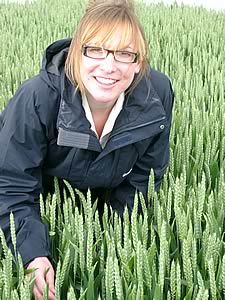 |
|||||||||
|
|||||||||||||||||||
|
|
Calculating Nitrogen Recommendations 11/02/09 The UK’s only fertiliser manufacturer, GrowHow UK, has updated the way it calculates Nitrogen recommendations for cereals and oilseed rape.
The GrowHow Nitrogen Calculator (N-Calc) is a practical tool that works out the total Nitrogen requirement of a crop taking into account crop type, anticipated yield, the amount of Nitrogen already in the crop, soil type and how much Nitrogen the crop will obtain from the soil. It has been used by the company in a variety of different formats for 20 years but, with the latest refinements and validation work completed by independent experts from ADAS, N-Calc is more accurate that it has ever been. “If there is one thing that the high fertiliser prices of 2008 achieved it was to focus farmers’ and their advisers’ minds on nutrient efficiency,” suggests Company Agronomist, Allison Grundy. “Whatever happens in 2009 we must not lose that focus.” Arguably, determining the amount of Nitrogen fertiliser to apply is the most important decision for any crop. Too much and not only will the risk of lodging increase but the chances of nitrate leaching will rise not to mention the unnecessary input cost incurred. On the other hand too little fertiliser will reduce yields and could impact on quality and marketability and hence profit. ADAS drew on all the available new data to bring the N-Calc up-to-date. Dr Pete Berry from ADAS High Mowthorpe led the two-year project. “In 2007 we updated the N-Calc for winter wheat and winter OSR. In 2008, we looked at winter and spring barley, oats and triticale. We found that there are only three really key influencers of Nitrogen rates for all these crops. They are the supply of N from the soil (SNS), soil type and potential yield.” “In practice, because at the time of calculating a recommendation some of the SNS will already have been taken up by the crop, you also need to include in the calculation an estimate of the amount of N currently in the crop,” he adds. Allison Grundy says that one of the key adjustments made following the ADAS work concerns the link between yield and Nitrogen requirement. “The link has evolved with the introduction of newer varieties – in wheat between 15 and 30kg N/ha is now required for every extra tonne of yield. In OSR an additional 30kg N/ha is required for every 0.5t/ha increase in yield. The current RB209 (2000 edition) does not reflect these changes,” she adds. In addition, whilst the current RB209 recommends an extra 40kg N/ha for milling wheat there is evidence to suggest that 50kg N/ha is now a more appropriate figure. The new N-Calc has been updated with this change as well. The best and most accurate way of measuring the Nitrogen the crop will recover from the soil is to use the N-Min service. However if farmers have been unable to take an N-Min sample, N-Calc is still a valuable tool. Under such circumstances it will draw on standard availability tables calculated from recent research. “In RB209 the SNS tables are based on the premise that previous cropping has a significant influence on the amount of Nitrogen that will be available to the following crop but previous cropping actually has much less influence than previously thought. The major influence on Nitrogen availability is organic matter content which makes soil texture a strong indicator of the amount of Additionally Available Nitrogen. Two further refinements have also been added for the 2009 season.” N-Calc offers guidance on the timing of Nitrogen applications. These timings are based on the size of the crop, the measured SNS and the end market” adds Allison. “We’ve also added useful information on the effect of the Break Even Ratio (BER) on the economic optimum. The economic optimum varies with the price paid for fertiliser and the price the crop makes when it is sold. The new N-Calc allows this data to be entered and will provide a theoretical N adjustment figure which growers and agronomists can consider when deciding how much N to apply to crops this spring. GrowHow N-Calc can be accessed through FACTS qualified GrowHow Advisers, Fieldsmen and agronomists. For more information contact the GrowHow Advice Centre on 0151 357 5758.
|
||||||||||||||||||

|
|
||||||||||||||||||
| home | agri-services | pedigree
pen | news | dairy | beef | machinery property | organisations | site map |
|||||||||||||||||||

